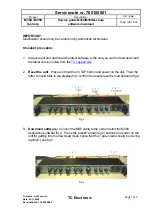
VISION
UDOO VISION User Manual - Rev. First Edition: 1.0 - Last Edition: 1.0 - Author: A.R. - Reviewed by M.B. Copyright © 2021 SECO S.p.A
16
2.1
Introduction
UDOO VISION is a system designed specifically for maker s / DIY market, made by a Single Board Computer in pico-ITX form factor (just 100 x 72mm), embedding
both a System-on-Chips (SoC) of the Intel
®
family of embedded SoCs formerly coded as Apollo Lake, and an Arduino
Leonardo compatible platform.
The UDOO VISION Single Board Computer is equipped with an active heatsink with FAN to prevent system hang-off or faults.
The UDOO VISION board represents a junction point between the PC world, represented by the Apollo Lake SoCs, and the Arduino Leonardo World, implemented
on-board using an Atmel ATmega32u4 microcontroller.
All the possible SoCs mounted on UDOO VISION are Quad Core Intel
®
XX CPUs with 1.6 GHz base frequency and with 64-bit instruction set and very
low TDP. This single chip solution includes the memory controller, which gives support for up 32-bit Quad-Channel LPDDR4 2400 MT/s Memory.
All SOCs embed an Integrated Intel
®
HD Graphics 500 series controller with up to 18 Execution Units, which offer high graphical performances, with support for
Microsoft
®
DirectX12, OpenGL 4.3, OpenCL 1.2, OpenGLES 3.0 and HW acceleration for video encoding and decoding of HEVC (H.265), H.264, JPEG/MJPEG.
It is also possible the HW video decoding only of VP9, MPEG2, VC-1 and WMV9. This embedded GPU is able to drive two independent displays, by using the eDP
and the + connectors. Any combinations of these video interfaces are supported.
Mass Storage capabilities of the UDOO VISION board include two external S-ATA Gen3 channels (one available on a standard SATA 7p Male connector, the other
on an M.2 Socket 2 Key B Slot), a standard 4-bit SD interface and one optional eMMC Drive soldered on board.
Further features usable on UDOO VISION board are WWAN M.2 Socket 2 Key B Slot connected to a miniSIM slot for modems, seven USB ports (two USB 3.0 on
standard Type-A socket, two USB 2.0 on dual internal pin header, one USB 2.0 on M.2 Socket 1 Key E Connectivity slot, one USB 3.0 on M.2 Key B slot and
another USB 2.0 port used for the communications with the Atmel microcontroller), HD Audio and three PCI Express lanes, (two PCI express lanes are used for the
implementation of the Gigabit Ethernet interfaces, one lane is carried out on M.2 Socket 1 Key E Connectivity Slot) up to 2x Gigabit Ethernet connections, one M.2
Socket 1 Key E Slot for WiFi+BT M.2 modules.
Through the Intel
®
Apollo Lake SoC s USB interface #6 pass all the communications with the Atmel microcontroller, which implements the Arduino Leonardo interface:
this situation reproduces exactly the situation of an external Arduino board connected to an X86 PC, with the advantages given by an integrated board solution.
All these features, combined together, make UDOO VISION the most powerful maker system ever.
Please refer to following chapter for a complete list of all the integrated peripherals and the characteristics.
















































